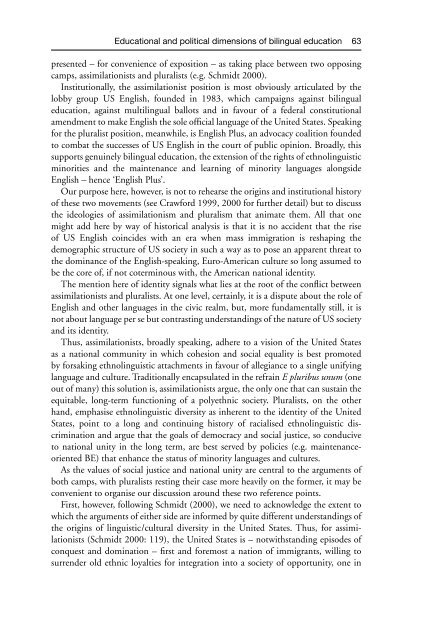Gibson Ferguson Language Planning and Education Edinburgh ...
Gibson Ferguson Language Planning and Education Edinburgh ...
Gibson Ferguson Language Planning and Education Edinburgh ...
Create successful ePaper yourself
Turn your PDF publications into a flip-book with our unique Google optimized e-Paper software.
<strong>Education</strong>al <strong>and</strong> political dimensions of bilingual education 63<br />
presented – for convenience of exposition – as taking place between two opposing<br />
camps, assimilationists <strong>and</strong> pluralists (e.g. Schmidt 2000).<br />
Institutionally, the assimilationist position is most obviously articulated by the<br />
lobby group US English, founded in 1983, which campaigns against bilingual<br />
education, against multilingual ballots <strong>and</strong> in favour of a federal constitutional<br />
amendment to make English the sole official language of the United States. Speaking<br />
for the pluralist position, meanwhile, is English Plus, an advocacy coalition founded<br />
to combat the successes of US English in the court of public opinion. Broadly, this<br />
supports genuinely bilingual education, the extension of the rights of ethnolinguistic<br />
minorities <strong>and</strong> the maintenance <strong>and</strong> learning of minority languages alongside<br />
English – hence ‘English Plus’.<br />
Our purpose here, however, is not to rehearse the origins <strong>and</strong> institutional history<br />
of these two movements (see Crawford 1999, 2000 for further detail) but to discuss<br />
the ideologies of assimilationism <strong>and</strong> pluralism that animate them. All that one<br />
might add here by way of historical analysis is that it is no accident that the rise<br />
of US English coincides with an era when mass immigration is reshaping the<br />
demographic structure of US society in such a way as to pose an apparent threat to<br />
the dominance of the English-speaking, Euro-American culture so long assumed to<br />
be the core of, if not coterminous with, the American national identity.<br />
The mention here of identity signals what lies at the root of the conflict between<br />
assimilationists <strong>and</strong> pluralists. At one level, certainly, it is a dispute about the role of<br />
English <strong>and</strong> other languages in the civic realm, but, more fundamentally still, it is<br />
not about language per se but contrasting underst<strong>and</strong>ings of the nature of US society<br />
<strong>and</strong> its identity.<br />
Thus, assimilationists, broadly speaking, adhere to a vision of the United States<br />
as a national community in which cohesion <strong>and</strong> social equality is best promoted<br />
by forsaking ethnolinguistic attachments in favour of allegiance to a single unifying<br />
language <strong>and</strong> culture. Traditionally encapsulated in the refrain E pluribus unum (one<br />
out of many) this solution is, assimilationists argue, the only one that can sustain the<br />
equitable, long-term functioning of a polyethnic society. Pluralists, on the other<br />
h<strong>and</strong>, emphasise ethnolinguistic diversity as inherent to the identity of the United<br />
States, point to a long <strong>and</strong> continuing history of racialised ethnolinguistic discrimination<br />
<strong>and</strong> argue that the goals of democracy <strong>and</strong> social justice, so conducive<br />
to national unity in the long term, are best served by policies (e.g. maintenanceoriented<br />
BE) that enhance the status of minority languages <strong>and</strong> cultures.<br />
As the values of social justice <strong>and</strong> national unity are central to the arguments of<br />
both camps, with pluralists resting their case more heavily on the former, it may be<br />
convenient to organise our discussion around these two reference points.<br />
First, however, following Schmidt (2000), we need to acknowledge the extent to<br />
which the arguments of either side are informed by quite different underst<strong>and</strong>ings of<br />
the origins of linguistic/cultural diversity in the United States. Thus, for assimilationists<br />
(Schmidt 2000: 119), the United States is – notwithst<strong>and</strong>ing episodes of<br />
conquest <strong>and</strong> domination – first <strong>and</strong> foremost a nation of immigrants, willing to<br />
surrender old ethnic loyalties for integration into a society of opportunity, one in






